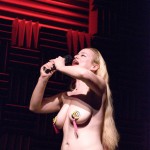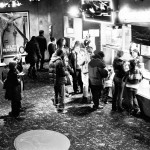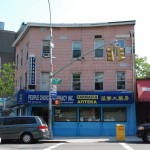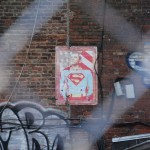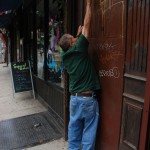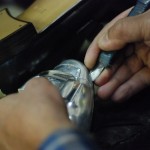-
Recent Posts
Recent Comments
- fantmann on music: life. love. passion
- ayleen.cruz on My dog Tito … (and Sam)
- Laura Callan on Christmas in NY
- Brendan Callan on Christmas in NY
- maung.aung on Colletion of Holiday Window Decoration
Archives
Categories
Meta
Author Archives: Sauchelli
Posts: 6 (archived below)
Comments: 8
Burlesque
The resurgence of burlesque has been percolating in the underground nightclubs for the past 10 years, but lately the neo-burlesque movement has taken mainstream stages at venues like Joe’s Pub, and has inspired upscale niche clubs such as The Box. Miss Clams Casino, “one delicious dish” as she calls herself-and the subject of this photo essay- began her career in burlesque right after witnessing her first performance. Seven years later, she’s still having a blast, now a producer and performer Clams can be seen rolling her suitcase full of props and costumes through the New York City subways up to four times a week and hitting a variety of local hang outs including, Littlefield, Public Assembly, or Nurse Bettie. From 1840-1960 burlesque served a very different social function than it does today. Once it pushed the boundaries of what was taboo, now it is an homage to the art of seduction in a society obsessed with sexuality and nudity. The neo-burlesque community takes its job very seriously, celebrating the body in all its unconventional beauty, reinventing a lost art.
Posted in Assignment Six - Final Project
17 Comments
Issue- Dilapidated Neighborhood Theatre
- For now it’s lights remain on.
- The marque lights up at night eluding to a novel time in theater going.
- The first floor concession stand gets busy on occasion.
- Employees still strut the classic bow tie and vest attire.
- Halls are quite.
- The view from the window however, is still lovely.
- The old cafe is now a standard concession stand.
- Screen sizes no longer impress.
- Few people attend show times.
- The projection rooms used to house a monitoring man.
- “Out of Order” signs mark faulty furniture.
- Some patrons take advantage of the missing seats by utilizing the extra leg room.
- Many seats are in need of repair here.
- Old photographs of the neighborhood give it that homey feel.
- Movie goers are directed to the appropriate theater.
- There are no self-serve ticket dispensers here.
- The old school theater uses printed papers taped to the ticket booth to display show times, rather than getting out the ladder to change the marque.
- The Pavilion Movie Theater sits across from Prospect Park, at the top of a notorious Slope.
The Pavilion movie theatre is a Park Slope staple, but where there was once a cozy neighborhood hang out, now stands a deteriorating empty memory.
The Pavilion Theatre occupies a beautiful historic building facing Prospect Park. For years it served as the neighborhood theatre, at one time it had a separate entrance that lead straight to the café located on the second floor. Every weekend children, parents, and teens lined up outside to buy tickets or pranksters tried to sneak from the café entrance into a theatre, either way it was alive. But today the theatre remains quite. The café is now a second concession stand, the theatre screens, chairs, and décor have not been renovated in years, and with the recent bed bug scare people aren’t braving it.
The place still has charm, employees wear white button down shirts, bow ties, and black vests like I imagine they did when the first movie theatre opened in 1906. But charm can only take it so far, sheets of paper that read “seat out of order” on the backs of movie seats are all too common. Every theatre room has missing seats all together or half disassembled ones. Stains on the curtains, floors, and seats are unforgivable, and on top of everything else there is a definite foul odor. Yet the theatre remains open seven days a week and some loyal patrons do still attend show times.
It’s hard to say how much longer The Pavilion can carry on in its current state, but some believe it doesn’t intend to. When the people stop going all together I wouldn’t surprise me if they simply shut the doors and converted it into luxury condos.
Community- Lower East Side
- The different types of people living together in a small area of NYC is what makes the LES so inviting and compelling.
- The latino community enjoys one of their classic snacks, shaved ice.
- These men were leaving the building projects, longtime residents.
- Parks are used by the public for basketball practice.
- Jewish boys roll around outside their homes in the afternoon.
- This pharmacy’s sign in various languages attracts people from the various ethnic groups living in the area.
- Father and son walk home under the Williamsburg bridge after a game.
- Children are picked up from school on bicycle.
- Friends meet to hang out on abandoned buildings stoops.
- People walk briskly past tenement buildings.
- Political banners are pasted on building facades.
- Health food stores cater to the new demographic.
- The graffiti the shows through this changing neighborhood is proof of the long standing residents presence still.
- Cigarettes and coffee are enjoyed outside in the street.
- A destination for young families.
- This new age skate shop appeals to the new time residents.
- You can see the evidence of long standing history mixed with the gentrification of today spilling out onto the streets.
- The Lower East Side is home to a diverse community.
This is the Lower East Side Manhattan.
The LES is a microcosm of all NYC. It was once home to thousands of poor immigrants looking to better their standard of living but instead they were ostracized; subjected to racism, no power, no equal rights. But over time thanks to people like Jacob Riis, who helped spread their story of injustice and expose through photographs the reality of their living situation, things did change in LES. Jewish people started to own and operate their own businesses, and they became successful. Artists started moving into the neighborhood for the low rents and great location. Musicians hung out at the local bars. Now developers are building luxury condos. The Lower East Side has everything, grunge, elitism, fashion, food, and nightlife. This is the LES today.
Posted in Assignment Four - Community
4 Comments
Environmental Portrait
Rafiel is a shoe repair man who’s store is located at 323 2 Ave, Manhattan. Originally from Uzbekistan Rafiel worked in a large factory making high end shoes before moving to NY and starting his own business. Now he shares his space with a seamstress to help pay the high rent, and tries to keep his prices low so customers keep coming back. It costs $10 to fix a pair of shoes.
Event
The Warriors movie screening and art exhibition event
Posted in Assignment One - Event
Comments Off on Event








